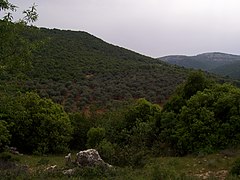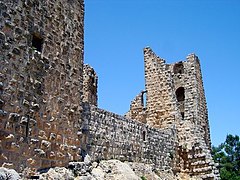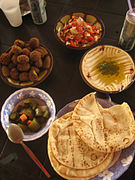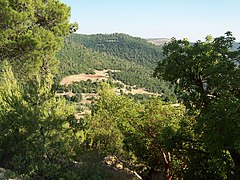Ajloun
Ajloun
عجلون | |
|---|---|
Town | |
 City of Ajloun from Ajloun Castle | |
| Nickname: Jordan Green | |
| Coordinates: 32°19′57″N 35°45′06″E / 32.33250°N 35.75167°E | |
| Grid position | 221/193 |
| Country | |
| Governorate | Ajloun |
| Municipality established | 1920 |
| Area | |
• Town | 4 km2 (2 sq mi) |
| • Metro | 30 km2 (10 sq mi) |
| Elevation | 719 m (2,508 ft) |
| Population (2015[1]) | |
• Town | 148,870 |
| • Metro | 190,200 |
| Time zone | UTC+2 (GMT) |
| • Summer (DST) | +3 |
| Area code | +(962)2 |
| Website | http://www.ajloun.gov.jo |
Ajloun (Arabic: عجلون, ‘Ajlūn), also spelled Ajlun, is the capital town of the Ajloun Governorate, a hilly town in the north of Jordan, located 76 kilometers (around 47 miles) north west of Amman. It is noted for its impressive ruins of the 12th-century Ajloun Castle.
Districts of Metropolitan Ajloun
[edit]There are five districts in the Greater Ajloun Municipality:

| District | |
|---|---|
| 1 | Ajloun |
| 2 | Ain Janna |
| 3 | Anjara |
| 4 | ِSakhra |
| 5 | Rawabi |
| 6 | Khet Al-Laban |
| 7 | Orjan |
| 8 | Kufranjeh |
History
[edit]In 1596, during the Ottoman Empire, Ajloun was noted in the census as being located in the nahiya of Ajloun in the liwa of Ajloun. It had a population of 313 Muslim households, and 20 Muslim bachelors, in addition to 2 Christian households. They paid taxes on various agricultural products, including olive trees, vineyards, fruit trees, vegetables and fruit garden, orchards, bayt al-mal wa mal ga'ib, goats and beehives, in addition to occasional revenues; a market toll and water mill; a total of 14,500 akçe.[2]
In 1838 Ajloun's inhabitants were predominantly Sunni Muslims and Greek Christians.[3]
The Jordanian census of 1961 found 5,390 inhabitants in Ajloun,[4] of whom 2,023 were Christians.[5]
Demographics
[edit]According to the Jordan national census of 2015, the population of the town of Ajloun was 148,870. For Ajloun Governorate as a whole, the population was about 176,080 in 2015. Muslims make up the majority of Ajloun's population. They live alongside the Christian population. The governorate of Ajloun is highly agricultural.
Historical sites
[edit]There is a theory that the town's name is connected with the Moabite King Eglon mentioned in the Bible, though the precise derivation is obscure.

Ajlun Castle is located on the site of an old monastery. It was renovated as a fort in 1184 by Izz al-Din Usama, a general in the army of Saladin. The castle controlled traffic along the road connecting Damascus and Egypt. The fortress marks the furthest limit of Frankish incursions during the Crusades. The Mamluks added a prominent tower to the castle. It was captured by the Mongols in 1260 and was partially destroyed in the process. Great damage was done by the Galilee earthquake of 1837 and the 1927 Jericho earthquake.[6]
Located in the center of Ajloun is the Great Ajlun Mosque. This mosque is one of the oldest extant in Jordan and dates back around 800 years. there have been reports of Greek writing in the oldest sections. The prayer tower is called "the filter" by some locals (referring to a cigarette filter, because half of the tower was built over a square tower, most likely a Church bell tower). In 2007 work began on improving the mosque to allow tourists to visit it. There are also reports that when the west wall fell apart in the heavy rains and snow in January 2013 a Bible and crosses were found in the old section.
Tell Mar Elias is located just outside the city limits. This site contains Byzantine church mosaics which were uncovered during the summer months for tourists. This location for Saint Elijah (Mar Elias) has been a shrine for centuries – people would go there and walk around the shrine singing ancient songs to cure a disease called "Rigeh". There are folk songs they sang for this visit. However, prior to the Pope's visit in 2000. A scholar on both Mar Elias and Ajlun Castle is Mohammad Abu-Abeileh in Jordan.
The Ajloun Forest Reserve is also located nearby. The whole area had been reputed to be the largest forested area in the Middle East – however, the area was largely deforested by the Turks to secure fuel for their railroad to Mecca.
The biblical figure Jephthah is said to have been buried in Ajloun.[7]
Climate
[edit]Ajloun, has a mediterranean climate (Köppen climate classification: Csa). The average annual temperature is 16.7 °C (62.1 °F), and around 467 mm (18.39 in) of precipitation falls annually.
| Climate data for Ajloun | |||||||||||||
|---|---|---|---|---|---|---|---|---|---|---|---|---|---|
| Month | Jan | Feb | Mar | Apr | May | Jun | Jul | Aug | Sep | Oct | Nov | Dec | Year |
| Mean daily maximum °C (°F) | 11.6 (52.9) |
12.8 (55.0) |
15.5 (59.9) |
20.5 (68.9) |
25.8 (78.4) |
28.6 (83.5) |
29.8 (85.6) |
29.9 (85.8) |
28.5 (83.3) |
25.5 (77.9) |
19.9 (67.8) |
13.6 (56.5) |
21.8 (71.3) |
| Daily mean °C (°F) | 7.8 (46.0) |
8.7 (47.7) |
10.8 (51.4) |
15.0 (59.0) |
19.7 (67.5) |
22.6 (72.7) |
24.2 (75.6) |
24.5 (76.1) |
22.8 (73.0) |
19.9 (67.8) |
14.9 (58.8) |
9.8 (49.6) |
16.7 (62.1) |
| Mean daily minimum °C (°F) | 4.1 (39.4) |
4.7 (40.5) |
6.2 (43.2) |
9.6 (49.3) |
13.7 (56.7) |
16.7 (62.1) |
18.6 (65.5) |
19.2 (66.6) |
17.1 (62.8) |
14.3 (57.7) |
9.9 (49.8) |
6.0 (42.8) |
11.7 (53.0) |
| Average precipitation mm (inches) | 111 (4.4) |
102 (4.0) |
78 (3.1) |
23 (0.9) |
6 (0.2) |
0 (0) |
0 (0) |
0 (0) |
0 (0) |
10 (0.4) |
48 (1.9) |
89 (3.5) |
467 (18.4) |
| Source: [8] | |||||||||||||
Topography
[edit]The Ajloun mountains are famous for their lush vegetation and thick green forests, many locals and tourists visit the area for hiking. Its highest mountain peaks reach around 1268 meters above sea level and Ajloun mountains receive a few snow storms every year, usually in the winter season from December to March. It's one of the country's most beautiful regions. Ajloun has a Mediterranean weather rainy and snowy in winter season and pleasant in the summer time.
Notable people
[edit]- Shaher Momani, Mathematics Professor (2009–present) at University of Jordan, grew up in and was educated in Ajloun.
Landmarks
[edit]- Ajloun Castle
- Tell Mar Elias
- Great Ajloun Mosque
- Listeb Mosque
- Ajloun Holy Spirit Church
- Shrine for Al-Khadir (St. George)
Gallery
[edit]-
Ajloun Mountains
-
Ajloun Castle
-
Breakfast at Ajloun
-
Forests surround Ajloun
-
Downtown Ajloun
-
The Great Ajloun Mosque
References
[edit]This article includes a list of general references, but it lacks sufficient corresponding inline citations. (November 2016) |
- ^ "Population estimation by locality" (PDF). dos.gov.jo. Archived from the original (PDF) on 5 June 2019. Retrieved 31 May 2023.
- ^ Hütteroth and Abdulfattah, 1977, p. 162
- ^ Smith, in Robinson and Smith, 1841, vol 3, 2nd appendix, p. 166
- ^ Government of Jordan, Department of Statistics, 1964, p. 13
- ^ Government of Jordan, Department of Statistics, 1964, pp. 115–116
- ^ Teller, Matthew (2012), The Rough Guide to Jordan, Rough Guides, p. 173, ISBN 978-1-85828-740-9
- ^ Levi-Naḥum, Yehuda (1986). "The graves of the fathers and of the righteous". Sefer ṣohar le-ḥasifat ginzei teiman (in Hebrew). Ḥolon, Israel: Mifʻal ḥaśifat ginze Teman. p. 253. OCLC 15417732.
In Ajloun [is buried] Jephthah the Gileadite.
- ^ "Climate: Ajloun". 17 January 2018.
Bibliography
[edit]- Government of Jordan, Department of Statistics (1964). First Census of Population and Housing. Volume I: Final Tables; General Characteristics of the Population (PDF).
- Hütteroth, W.-D.; Abdulfattah, K. (1977). Historical Geography of Palestine, Transjordan and Southern Syria in the Late 16th Century. Erlanger Geographische Arbeiten, Sonderband 5. Erlangen, Germany: Vorstand der Fränkischen Geographischen Gesellschaft. ISBN 3-920405-41-2.
- Robinson, E.; Smith, E. (1841). Biblical Researches in Palestine, Mount Sinai and Arabia Petraea: A Journal of Travels in the year 1838. Vol. 3. Boston: Crocker & Brewster.
Further reading
[edit]- Dobrzańska-Bzowska, Magdalena; Bzowski, Krzysztof (2008). Praktyczny przewodnik – Bliski Wschód (in Polish). Bielsko-Biała: Wydawnictwo Pascal. pp. 157–158. ISBN 978-83-7513-146-8.
External links
[edit]- [1] Archived 14 September 2012 at the Wayback Machine
- Jordan Tourism Board Archived 2014-06-16 at the Wayback Machine
- Middle East Travel Guide Archived 16 December 2021 at the Wayback Machine
- Ajlun Discussion Forum (in Arabic)
- Photos of Ajlun at the American Center of Research







